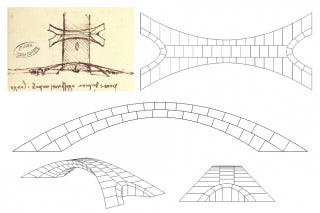500 Years Later, MIT Proves That Da Vinci's Bridge Design Works
- In the early 1500s, Leonardo da Vinci designed a hypothetical bridge for the Sultan of the Ottoman Empire.
- It was rejected. Over 500 years later, an MIT team has recreated the design with a model and have showed that it would have worked.
- Da Vinci's design incorporates architectural techniques that would have not been seen for another 300 years.
Researchers at MIT have proven Leonardo da Vinci correct yet again, this time involving his design for what would have been at the time a revolutionary bridge design. Although clients rejected da Vinci's work at the time, over 500 years later, the researchers have proven that his bridge would have worked.
The famed Renaissance Man made his living working with wealthy patrons—people like Ludovico Sforza, the Duke of Milan, who commissioned his painting "The Last Supper." But da Vinci did not want to limit himself to Italian patrons. When Sultan Bayezid II of the Ottoman Empire put out a request for proposals for a bridge connecting capital city Constantinople (now Istanbul) with its neighbor city Galata, da Vinci was eager for the chance to win the contract.
Da Vinci's proposal was radically different than the standard bridge at the time. As described by the MIT group, it was approximately 918 feet long (218 meters, though neither system of measurement had been developed yet) and would have consisted of a flattened arch "tall enough to allow a sailboat to pass underneath with its mast in place...but that would cross the wide span with a single enormous arch," according to an MIT press statement. It would have been the longest bridge in the world at the time by a significant measure, using an unheard of style of design.
It wasn't just length or style that set da Vinci's bridge apart. It also had safety features unheard of at the time. One of the biggest challenges facing any bridge design is that it has to exist in nature no matter the conditions, including wind. Strong winds have forced many bridge, including relatively modern bridges from the 20th century, into lateral oscillations leading to collapse. Da Vinci would have added what are known as wing walls, abutments out to the side of the bridge, steadying it during harsh conditions. They are now common design elements of modern bridges.
"It's incredibly ambitious," says recent graduate student Karly Bast, who worked on the project with professor of architecture and of civil and environmental engineering John Ochsendorf and undergraduate Michelle Xie on the project. "It was about 10 times longer than typical bridges of that time."
Bast, Oschsendorf, and Xie analyzed available documents regarding the bridge, the possible materials and construction methods of the period, and the geographic conditions of the river estuary then known as the Golden Horn, now called Haliç, where the Sultan wanted the bridge. Da Vinci's sketches and letters to the Sultan regarding the bridge can be found in what's known as Manuscript L, a small Codex stored in the Institut de France in Paris. Da Vinci wrote that
See full article on https://www.popularmechanics.com"I, your faithful servant, understand that it has been your intention to erect a bridge from Galata (Pera) to Stambul… across the Golden Horn (‘Haliç”), but this has not been done because there were no experts available. I, your subject, have determined how to build the bridge. It will be a masonry bridge as high as a building, and even tall ships will be able to sail under it."



